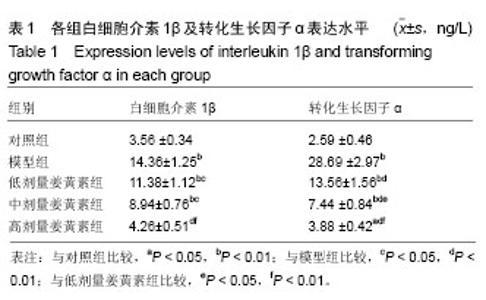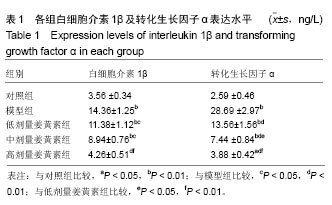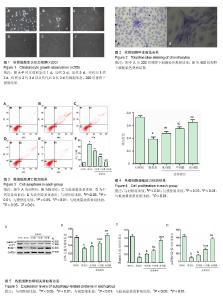| [1] Glyn-Jones S, Palmer AJ, Agricola R, et al. Osteoarthritis. Lancet. 2015;386(9991):376-387.[2] Lane NE, Shidara K, Wise BL. Osteoarthritis year in review 2016: clinical. Osteoarthritis Cartilage. 2017;25(2):209.[3] Vilá S. Inflammation in Osteoarthritis. P R Health Sci J. 2017;36(3): 123-129.[4] Craft AM, Rockel JS, Nartiss Y, et al. Generation of articular chondrocytes from human pluripotent stem cells. Nat Biotechnol. 2015;33(6):638-645.[5] Vinatier C, Merceron C, Guicheux J. Osteoarthritis: from pathogenic mechanisms and recent clinical developments to novel prospective therapeutic options. Drug Discov Today. 2016; 21(12):1932-1937.[6] Punzi L, Galozzi P, Luisetto R, et al. Post-traumatic arthritis: overview on pathogenic mechanisms and role of inflammation. Rmd Open. 2016;2(2):e000279.[7] 袁普卫,杨威,康武林,等.骨性关节炎发病机制研究进展[J].中国骨质疏松杂志,2016,22(7):902-906.[8] Rubio-Terres C, Rubio-Rodriguez D. Economic evaluation of chondroitin sulfate and non-steroidal antiinflammatory drugs for the treatment of osteoarthritis. Value Health. 2015;18(7):A640.[9] Goel A, Kunnumakkara AB, Aggarwal BB. Curcumin as "Curecumin": from kitchen to clinic. Biochem Pharmacol. 2008;75(4):787-809.[10] Jaggi, Sushil, Gupta K, et al. Synthesis and pharmacological activity evaluation of Curcumin derivatives. Chin Chem Lett. 2016;27(7): 1067-1072.[11] 田华,张松峰,尤丽菊,等.姜黄素对糖尿病肾病大鼠肾脏炎症损伤的保护作用[J].细胞与分子免疫学杂志,2013,29(11):1166-1168.[12] 雷军荣,秦军,张晶,等.姜黄素对大鼠缺血性脑损伤炎症反应和血脑屏障通透性的影响[J].中国药理学通报,2010,26(1):120-123.[13] 肖雪飞,杨明施,孙圣华.姜黄素对脓毒症急性肺损伤的炎症反应及NF-κB信号通路的影响[J].中国现代医学杂志, 2013,23(30):19-22.[14] 张锐,刘世清.姜黄素保护关节软骨抑制骨关节炎的作用和机制[J].中国组织工程研究,2015,19(2):277-282.[15] 高改霞,卫小春,李凯,等.大鼠膝关节软骨不同染色方法的差异[J].中国组织工程研究,2010,14(24):4385-4389.[16] Zhang LB, Man ZT, Li W, et al. Calcitonin protects chondrocytes from lipopolysaccharide-induced apoptosis and inflammatory response through MAPK/Wnt/NF-κB pathways. Mol Immunol. 2017;87:249-257.[17] Zhao C, Wang Y, Jin H, et al. Knockdown of microRNA-203 alleviates LPS-induced injury by targeting MCL-1 in C28/I2 chondrocytes. Exp Cell Res. 2017;359(1):171-178.[18] 袁昊,曾晖,肖德明,等.白藜芦醇通过NF-κB信号通路抑制软骨细胞炎症因子的表达[J].中华骨与关节外科杂志, 2016, 9(1):75-79.[19] 方春凤,狄朋桃,吴洋.中医药干预骨关节炎软骨细胞凋亡研究进展[J].中华中医药学刊,2015,(8)1:919-1921.[20] 毕文杰,穆小静,祖丽皮艳•阿布力米特,等.姜黄素新型靶向制剂研究进展[J].中国药学杂志,2015,50(4): 323-329.[21] 李旭升,陈慧,甄平,等.JAK2/STAT3信号通路介导姜黄素在骨性关节炎软骨细胞代谢中的影响[J].中国骨伤,2016,29(12):1104-1109.[22] 马勇,王礼宁,郭杨,等.姜黄素通过调节Wnt/β-catenin信号通路促进软骨细胞增殖的研究[J].广州中医药大学学报, 2017,34(1):90-95.[23] 陈琼,赵明才,陈悦,等.姜黄素对骨关节炎软骨细胞增殖及分泌MMP-13, IL-6的影响[J].现代中西医结合杂志, 2013,22(5):459-461.[24] Figueroa PLD, Lotz M, Blanco FJ, et al. Autophagy activation protects from mitochondrial dysfunction in human chondrocytes. Arthritis Rheum. 2015;67(4):966-976.[25] 王浩,曹飞,斯海波,等.雷帕霉素调控自噬在骨关节炎软骨细胞退变中的机制研究[J].中华骨与关节外科杂志, 2017,10(3):248-253.[26] Cheng NT, Guo A, Meng H. The protective role of autophagy in experimental osteoarthritis, and the therapeutic effects of Torin 1 on osteosrthritis by activating autophagy. BMC Musculoskelet Disord. 2016;17(1):150.[27] 李春亮,李钊伟,秦凤.Sirt1调控软骨细胞自噬在骨关节炎中作用及机制[J].重庆医学,2016,45(15):2118-2122.[28] 赵雅宁,孙竹梅,刘俊杰,等.大鼠蛛网膜下腔出血后细胞外调节蛋白激酶1/2激活介导海马区神经细胞自噬[J].中国神经精神疾病杂志, 2017, 43(2):110-115.[29] 毕亚光,王光宇,刘向东,等.高糖后低糖过程通过ERK1/2信号途径增强H9c2心肌细胞自噬的功能[J].医学研究杂志, 2017,46(3):65-69.[30] Yeh PS, Wang W, Chang YA, et al. Honokiol induces autophagy of neuroblastoma cells through activating the PI3K/Akt/mTOR and endoplasmic reticular stress/ERK1/2 signaling pathways and suppressing cell migration. Cancer Lett. 2016;370(1):66-77.[31] Huang Q, Liu X, Cao C, et al. Apelin-13 induces autophagy in hepatoma HepG2 cells through ERK1/2 signaling pathway-dependent upregulation of Beclin1. Oncol Lett. 2016;11(2):1051-1056. |



